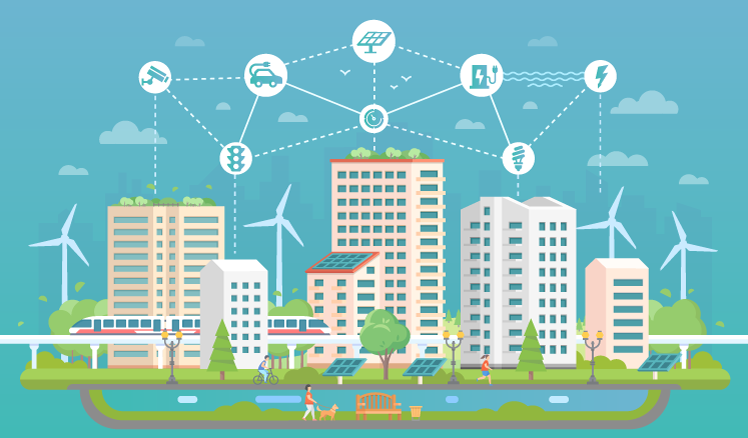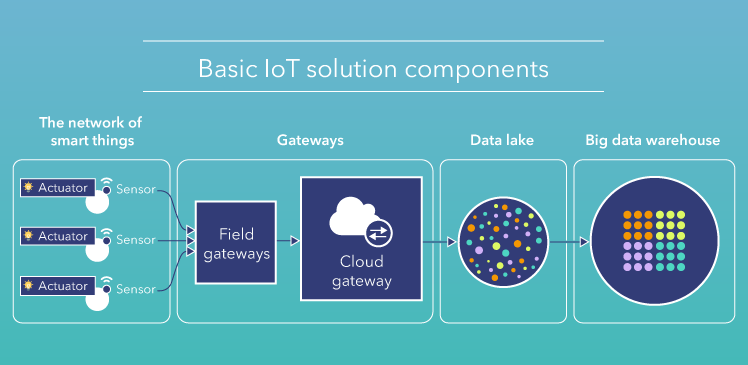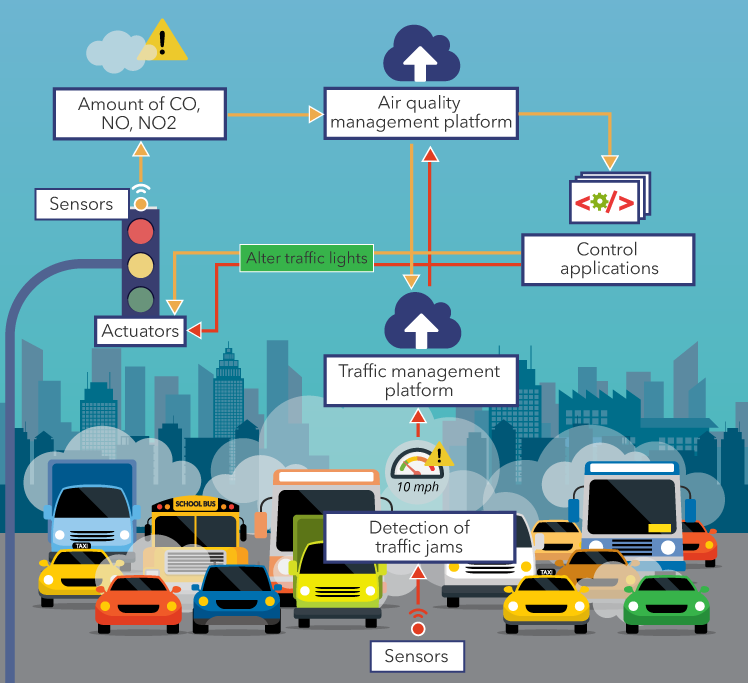IoT for Smart Cities: Use Cases and Implementation Strategies
The UN predicts that by 2050, the world’s urban population is likely to double and reach the point of nearly 6.7 million people. As the number of urban residents grows, cities face new opportunities… And challenges. To prevent environmental deterioration, avoid sanitation problems, mitigate traffic congestion, and thwart urban crime, municipalities turn to the Internet of Things (IoT).
IoT has the potential to tame the pressure of urbanization, create new experience for city residents, and make day-to-day living more comfortable and secure.
In this article, we will share our IoT consulting experience and shed light on the smart city applications, present an optimal approach to the implementation of smart city solutions, as well as explore the peculiarities of rolling out IoT solutions in cities of different sizes.

IoT use cases for smart cities
IoT-enabled smart city use cases span multiple areas: from contributing to a healthier environment and improving traffic to enhancing public safety and optimizing street lighting. Below, we provide an overview of the most popular use cases that are already implemented in smart cities across the globe.
Road traffic
Smart cities ensure that their citizens get from point A to point B as safely and efficiently as possible. To achieve this, municipalities turn to IoT development and implement smart traffic solutions.
Smart traffic solutions use different types of sensors, as well as fetch GPS data from drivers’ smart phones to determine the number, location and the speed of vehicles. At the same time, smart traffic lights connected to a cloud management platform allow monitoring green light timings and automatically alter the lights based on current traffic situation to prevent congestion. Additionally, using historical data, smart solutions for traffic management can predict where the traffic could go and take measures to prevent potential congestion.
For example, being one of the most traffic-affected cities in the world, Los Angeles has implemented a smart traffic solution to control traffic flow. Road-surface sensors and closed-circuit television cameras send real-time updates about the traffic flow to a central traffic management platform. The platform analyzes the data and notifies the platform users of congestion and traffic signal malfunctions via desktop user apps. Additionally, the city is deploying a network of smart controllers to automatically make second-by-second traffic lights adjustments, reacting to changing traffic conditions in real time.
Smart parking
With the help of GPS data from drivers’ smartphones (or road-surface sensors embedded in the ground on parking spots), smart parking solutions determine whether the parking spots are occupied or available and create a real-time parking map. When the closest parking spot becomes free, drivers receive a notification and use the map on their phone to find a parking spot faster and easier instead of blindly driving around.
Public transport
The data from IoT sensors can help to reveal patterns of how citizens use transport. Public transportation operators can use this data to enhance traveling experience, achieve a higher level of safety and punctuality. To carry out a more sophisticated analysis, smart public transport solutions can combine multiple sources, such as ticket sales and traffic information.
In London, for instance, some train operators predict the loading of train passenger cars on their trips in and out of the city. They combine the data from ticket sales, movement sensors, and CCTV cameras installed along the platform. Analyzing this data, train operators can predict how each car will load up with passengers. When a train comes into a station, train operators encourage passengers to spread along the train to maximize the loading. By maximizing the capacity use, train operators avoid train delays.
Utilities
IoT-equipped smart cities allow citizens to save money by giving them more control over their home utilities. IoT enables different approaches to smart utilities:
- Smart meters & billing
With a network of smart meters, municipalities can provide citizens with cost-effective connectivity to utilities companies’ IT systems. Now, smart connected meters can send data directly to a public utility over a telecom network, providing it with reliable meter readings. Smart metering allows utilities companies to bill accurately for the amount of water, energy and gas consumed by each household.
- Revealing consumption patterns
A network of smart meters enables utilities companies to gain greater visibility and see how their customers consume energy and water. With a network of smart meters, utilities companies can monitor demand in real time and redirect resources as necessary or encourage consumers to use less energy or water at times of shortage.
- Remote monitoring
IoT smart city solutions can also provide citizens with utility management services. These services allow citizens to use their smart meters to track and control their usage remotely. For instance, a householder can turn off their home central heating using a mobile phone. Additionally, if a problem (e.g., a water leakage) occurs, utilities companies can notify householders and send specialists to fix it.
Street lighting
IoT-based smart cities make maintenance and control of street lamps more straightforward and cost-effective. Equipping streetlights with sensors and connecting them to a cloud management solution helps to adapt lighting schedule to the lighting zone.
Smart lighting solutions gather data on illuminance, movement of people and vehicles, and combine it with historical and contextual data (e.g., special events, public transport schedule, time of day and year, etc.) and analyze it to improve the lighting schedule. As a result, a smart lighting solution “tells” a streetlight to dim, brighten, switch on or switch off the lights based on the outer conditions.
For instance, when pedestrians cross the road, the lights around the crossings can switch to a brighter setting; when a bus is expected to arrive at a bus stop, the streetlights around it can be automatically set brighter than those further away, etc.
Waste management
Most waste collection operators empty containers according to predefined schedules. This is not a very efficient approach since it leads to the unproductive use of waste containers and unnecessary fuel consumption by waste collecting trucks.
IoT-enabled smart city solutions help to optimize waste collecting schedules by tracking waste levels, as well as providing route optimization and operational analytics.
Each waste container gets a sensor that gathers the data about the level of the waste in a container. Once it is close to a certain threshold, the waste management solution receives a sensor record, processes it, and sends a notification to a truck driver’s mobile app. Thus, the truck driver empties a full container, avoiding emptying half-full ones.
Environment
IoT-driven smart city solutions allow tracking parameters critical for a healthy environment in order to maintain them at an optimal level. For example, to monitor water quality, a city can deploy a network of sensors across the water grid and connect them to a cloud management platform. Sensors measure pH level, the amount of dissolved oxygen and dissolved ions. If leakage occurs and the chemical composition of water changes, the cloud platform triggers an output defined by the users. For example, if a Nitrate (NO3-) level exceeds 1 mg/L, a water quality management solution alerts maintenance teams of contamination and automatically creates a case for field workers, who then start fixing the issue.
Another use case is monitoring air quality. For that, a network of sensors is deployed along busy roads and around plants. Sensors gather data on the amount of CO, nitrogen, and sulfur oxides, while the central cloud platform analyzes and visualizes sensor readings, so that platform users can view the map of air quality and use this data to point out areas where air pollution is critical and work out recommendations for citizens.
Public safety
For enhancing public safety, IoT-based smart city technologies offer real-time monitoring, analytics, and decision-making tools. Combining data from acoustic sensors and CCTV cameras deployed throughout the city with the data from social media feed and analyzing it, public safety solutions can predict potential crime scenes. This will allow the police to stop potential perpetrators or successfully track them.
For example, more than 90 cities across the United States use a gunshot detection solution. The solution uses connected microphones installed throughout a city. The data from microphones passes over to the cloud platform, which analyzes the sounds and detects a gunshot. The platform measures the time it took for the sound to reach the microphone and estimates the location of the gun. When the gunshot and its location are identified, cloud software alerts the police via a mobile app.
Iterative approach to implementing smart city solutions
The range of smart city applications is highly diverse. What they have in common is the approach to implementation. Whether municipalities plan to automate waste collection or improve street lighting, they should start with the foundation – a basic smart city platform. If a municipality prefers to expand the range of smart city services in the future, it will be possible to upgrade the existing architecture with new tools and technologies without having to rebuild it.
Here is a six-step implementation model to follow for creating an efficient and scalable IoT architecture for a smart city.
Stage 1: basic IoT-based smart city platform
To be able to scale, smart city implementation should start with designing a basic architecture – it will serve as a springboard for future enhancements and allow adding new services without losing functional performance. A basic IoT solution for smart cities includes four components:
- The network of smart things
A smart city – as any IoT system – uses smart things equipped with sensors and actuators. The immediate goal of sensors is to collect data and pass it to a central cloud management platform. Actuators allow devices to act - alter the lights, restrict the flow of water to the pipe with leakage, etc.
- Gateways
Any IoT system comprises two parts – a “tangible” part of IoT devices and network nodes and a cloud part. The data cannot simply pass from one part to the other. There must be doors – field gateways. Field gateways facilitate data gathering and compression by preprocessing and filtering data before moving it to the cloud. The cloud gateway ensures secure data transmission between field gateways and the cloud part of a smart city solution.
- Data lake
The main purpose of a data lake is to store data. Data lakes preserve data in its raw state. When the data is needed for meaningful insights, it’s extracted and passed over to the big data warehouse.
- Big data warehouse
A big data warehouse is a single data repository. Unlike data lakes, it contains only structured data. Once the value of data has been defined, it’s extracted, transformed and loaded into the big data warehouse. Moreover, it stores contextual information about connected things, e.g., when sensors were installed, as well as the commands sent to devices’ actuators by control applications.

Stage 2: Monitoring and basic analytics
With data analytics, it is possible to monitor devices’ environment and set rules for control applications (we cover them at stage 4) to carry out a particular task.
For example, analyzing the data from soil moisture sensors deployed across a smart park, cities can set rules for the electronic valves to close or open based on the identified moisture level. The data collected with sensors can be visualized on a single platform dashboard, allowing users to know the current state of each park zone.
Stage 3: Deep analytics
Processing IoT-generated data, city administrations can go beyond monitoring & basic analytics and identify patterns and hidden correlations in sensor data. Data analytics uses advanced techniques like machine learning (ML) and statistical analysis. ML algorithms analyze historical sensor data stored in the big data warehouse to identify trends and create predictive models based on them. The models are used by control applications that send commands to IoT devices’ actuators. Here is how it applies in practice.
Unlike a traditional traffic light that is programmed to display a particular signal for a definite period, a smart traffic light can adapt signal timings to the traffic scenario. ML algorithms are applied to historical sensor data to reveal traffic patterns and adjust signal timings, helping to improve average vehicle speed and avoid congestions.
Stage 4: Smart control
Control applications ensure better automation of smart city objects by sending commands to their actuators. Basically, they “tell” actuators what to do to solve a particular task. There are rule-based and ML-based control applications. Rules for rule-based control applications are defined manually, while ML-based control applications use models created by ML algorithms. These models are identified based on data analysis; they are tested, approved and regularly updated.
Stage 5: Instant interacting with citizens via user applications
Along with the possibility of automated control, there should always be an option for users to influence the behavior of smart city applications (for example, in case of emergency). This task is carried out by user applications.
User applications allow citizens to connect to the central smart city management platform to monitor and control IoT devices, as well as receive notifications and alerts. For example, using GPS data from drivers’ smartphones, a smart traffic management solution identifies a traffic jam. To prevent even bigger congestion, the solution automatically sends a notification to the drivers in the area, encouraging them to take a different route.
At the same time, employees at a traffic control center who use a desktop user app receive a ‘congestion alert.’ To relieve the congestion and re-route part of the traffic, they send a command to the traffic lights’ actuators to alter the signals.
Stage 6: Integrating several solutions
Achieving “smartness” is not a one-time action – it is a continuous process. Implementing IoT-based smart city solutions today, municipalities should think of services they might like to implement tomorrow. It implies not only increasing the number of sensors but, more importantly, the number of functions. Let’s illustrate this functional scalability with the example of a smart city solution for traffic monitoring.
A city deploys a traffic management solution to detect traffic jams in real time and manage traffic lights to reduce traffic in the areas with intensive traffic. After some time, the city decides to ensure city traffic doesn’t harm the environment and integrates the traffic management solution with a smart air quality monitoring solution. Cross-solution integration allows controlling both traffic and air quality in the city dynamically.
For that, traffic lights or street lights along the roads can be equipped with sensors that monitor air quality. Sensors measure the amount of CO, NO, and NO2 in the air and pass data records to a central air quality management platform for processing. If the amount of harmful gases in the air is critical, control applications apply rules or use models to take an output action, e.g., ‘alter traffic lights.’ Before that, there is a need to make sure that altering traffic lights won’t cause accidents or blockages in other areas. It is possible due to the integration of the traffic management solution to the air quality management solution. The traffic management platform performs real-time analysis and identifies if it is possible to alter the traffic lights. If altering the lights is acceptable, control applications send a command to the traffic lights’ actuators, which execute the command.

Applying an iterative approach helps municipalities to reduce implementation costs, get a faster pay-off and make the benefits of smart solutions visible for citizens sooner.
Adapting IoT implementation strategy to the city size
Iterative approach can be leveraged in cities of different sizes. In larger ones, it helps to deal with the scale and complexity of implementation; in smaller ones, it helps to reduce investments in smart solutions and use constrained infrastructure resources more reasonably. However, starting a smart project in a smaller city, municipalities have some more points to consider.
On the way to smartness, midsized and small cities face many barriers, including budgetary and procurement shortages, limited resources for public services, under-resourced IT infrastructure, etc. However, it doesn’t mean a smaller city cannot be a smart city.
Starting a smart initiative in a city of medium or small size, it makes sense to begin with the projects that do not require huge investments and deliver tangible return on investments, such as smart parking or waste management, and use the established infrastructure to implement new services.
For example, the town of Vail, CO has less than 6,000 inhabitants but boasts an extensive smart infrastructure. The town started smart city development with connected streetlights. Later, they used the established infrastructure to broaden the range of services and topped it with smart parking and irrigation systems.
To determine which applications are a good fit for smaller cities, we’ve analyzed them by the volume of investments, required infrastructure, pay-off period, the visibility of benefits for citizens and came up with the following table:

Another non-trivial way to enhance the affordability and accessibility of smart applications is sharing a common platform with a larger city. The cloud nature of IoT-enabled smart city solutions is suitable for that. This way, smart city solutions of both large and smaller smart cities are connected to and managed via a single cloud platform. By sharing the platform based on open data, several smart cities form a common urban ecosystem. One of the examples of such sharing is the Iberian Smart Cities Network, which currently includes 111 cities in Portugal and Spain. The network comprises cities of different sizes, which cooperate in multiple areas including smart energy, mobility, environment, and transport.
Let’s sum it up
IoT helps cities connect and manage multiple infrastructure and public services. From smart lighting and road traffic to connected public transport and waste management – the range of use cases is highly diverse. What they have in common is the outcomes. Applying IoT solutions leads to reduced costs for energy, optimized use of natural resources, safer cities, and a healthier environment.
However, to enjoy these benefits, municipalities should take a consistent approach to design a functional and scalable smart city architecture. Well-designed, it will allow to reduce investments in IoT development and hasten the implementation of smart city solutions, still leaving space for expansion.

